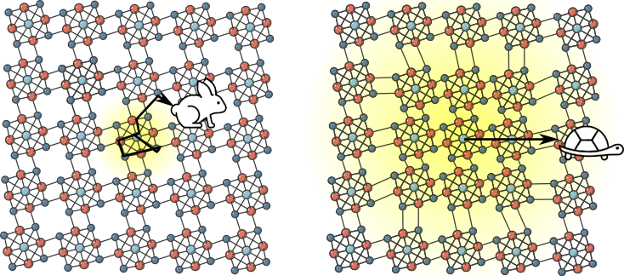A Superatomic Semiconductor Sets a Speed Record
Columbia chemists discover ballistic flow in a quantum material. The finding could help overcome shortcomings in semiconductors.

Semiconductors—most notably, silicon—underpin the computers, cellphones, and other electronic devices that power our daily lives, including the device on which you are reading this article. As ubiquitous as semiconductors have become, they come with limitations. The atomic structure of any material vibrates, which creates quantum particles called phonons. Phonons in turn cause the particles—either electrons or electron-hole pairs called excitons—that carry energy and information around electronic devices to scatter in a matter of nanometers and femtoseconds. This means that energy is lost in the form of heat, and that information transfer has a speed limit.
The search is on for better options. Writing in Science, a team of chemists at Columbia University led by Jack Tulyag, a PhD student working with chemistry professor Milan Delor, describes the fastest and most efficient semiconductor yet: a superatomic material called Re6Se8Cl2.
Rather than scattering when they come into contact with phonons, excitons in Re6Se8Cl2 actually bind with phonons to create new quasiparticles called acoustic exciton-polarons. Although polarons are found in many materials, those in Re6Se8Cl2 have a special property: they are capable of ballistic, or scatter-free, flow. This ballistic behavior could mean faster and more efficient devices one day.
"In terms of energy transport, Re6Se8Cl2 is the best semiconductor that we know of, at least so far."
In experiments run by the team, acoustic exciton-polarons in Re6Se8Cl2 moved fast—twice as fast as electrons in silicon—and crossed several microns of the sample in less than a nanosecond. Given that polarons can last for about 11 nanoseconds, the team thinks the exciton-polarons could cover more than 25 micrometers at a time. And because these quasiparticles are controlled by light rather than an electrical current and gating, processing speeds in theoretical devices have the potential to reach femtoseconds—six orders of magnitude faster than the nanoseconds achievable in current Gigahertz electronics. All at room temperature.
“In terms of energy transport, Re6Se8Cl2 is the best semiconductor that we know of, at least so far,” Delor said.
A Quantum Version of the Tortoise and the Hare
Re6Se8Cl2 is a superatomic semiconductor created in the lab of collaborator Xavier Roy. Superatoms are clusters of atoms bound together that behave like one big atom, but with different properties than the elements used to build them. Synthesizing superatoms is a specialty of the Roy lab, and they are a main focus of Columbia’s NSF-funded Material Research Science and Engineering Center on Precision Assembled Quantum Materials. Delor is interested in controlling and manipulating the transport of energy through superatoms and other unique materials developed at Columbia. To do this, the team builds super-resolution imaging tools that can capture particles moving at ultrasmall, ultrafast scales.
When Tulyag first brought Re6Se8Cl2 into the lab, it wasn’t to search for a new and improved semiconductor—it was to test the resolution of the lab’s microscopes with a material that, in principle, shouldn’t have conducted much of anything. “It was the opposite of what we expected,” said Delor. “Instead of the slow movement we expected, we saw the fastest thing we’ve ever seen.”
Tulyag and his peers in the Delor group spent the next two years working to pinpoint why Re6Se8Cl2 showed such remarkable behavior, including developing an advanced microscope with extreme spatial and temporal resolution that can directly image polarons as they form and move through the material. Theoretical chemist Petra Shih, a PhD student working in Timothy Berkelbach’s group, also developed a quantum mechanical model that provides an explanation for the observations.
The new quasiparticles are fast, but, counterintuitively, they accomplish that speed by pacing themselves—a bit like the story of the tortoise and the hare, Delor explained.

What makes silicon a desirable semiconductor is that electrons can move through it very quickly, but like the proverbial hare, they bounce around too much and don’t actually make it very far, very fast in the end. Excitons in Re6Se8Cl2 are, comparatively, very slow, but it’s precisely because they are so slow that they are able to meet and pair up with equally slow-moving acoustic phonons. The resulting quasiparticles are “heavy” and, like the tortoise, advance slowly but steadily along. Unimpeded by other phonons along the way, acoustic exciton-polarons in Re6Se8Cl2 ultimately move faster than electrons in silicon.
The Semiconductor Search Continues
Like many of the emerging quantum materials being explored at Columbia, Re6Se8Cl2 can be peeled into atom-thin sheets, a feature that means they can potentially be combined with other similar materials in the search for additional unique properties. Re6Se8Cl2, however, is unlikely to ever make its way into a commercial product—the first element in the molecule, Rhenium, is one of the rarest on earth and extremely expensive as a result.
But with the new theory from the Berkelbach group in hand along with the advanced imaging technique that Tulyag and the Delor group developed to directly track the formation and movement of polarons in the first place, the team is ready to see if there are other superatomic contenders capable of beating Re6Se8Cl2’’s speed record.
“This is the only material that anyone has seen sustained room-temperature ballistic exciton transport in. But we can now start to predict what other materials might be capable of this behavior that we just haven’t considered before,” said Delor. “There is a whole family of superatomic and other 2D semiconductor materials out there with properties favorable for acoustic polaron formation.”
Read More: Jakhangirkhodja Tulyagankhodjaev et al. Room temperature wavelike exciton transport in a van der Waals superatomic semiconductor. Science 2023. DOI: 10.1126/science.adf2698
In addition to Columbia’s NSF-funded MRSEC, this work was supported by the US Air Force Office of Scientific Research.
